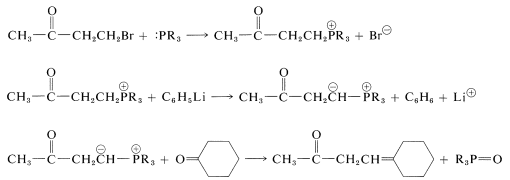16.9: Protección de Grupos Carbonil
- Page ID
- 73552
Hay pocas reacciones de aldehídos y cetonas que no afecten de alguna manera la función carbonilo. Por esta razón, puede ser necesario proteger la función carbonilo cuando es deseable evitar la reacción en esta función. Por ejemplo, puede planear sintetizar 4-ciclohexildeno-2-butanona por medio de una reacción de Wittig (Sección 16-4A), que implicaría la siguiente secuencia:

Esta síntesis fallaría en la segunda etapa debido a que el fenillitio se añadiría irreversiblemente al grupo carbonilo. Para evitar esto, el grupo carbonilo tendría que estar protegido o bloqueado, y el método de bloqueo más generalmente útil es convertir el grupo carbonilo en un cetal, generalmente un cetal cíclico:

Con el grupo carbonilo adecuadamente protegido, la síntesis propuesta tendría muchas mejores posibilidades de éxito:

Observe que el grupo carbonilo se regenera por hidrólisis ácida en el último paso.
Colaboradores y Atribuciones
- John D. Robert and Marjorie C. Caserio (1977) Basic Principles of Organic Chemistry, second edition. W. A. Benjamin, Inc. , Menlo Park, CA. ISBN 0-8053-8329-8. This content is copyrighted under the following conditions, "You are granted permission for individual, educational, research and non-commercial reproduction, distribution, display and performance of this work in any format."


